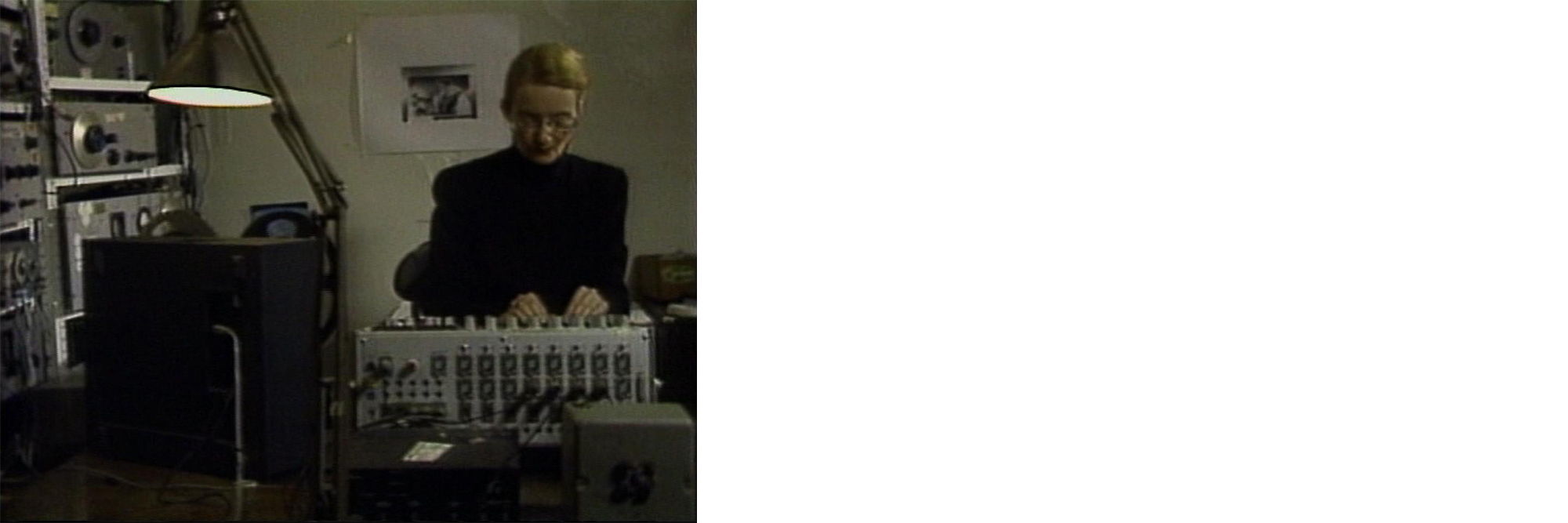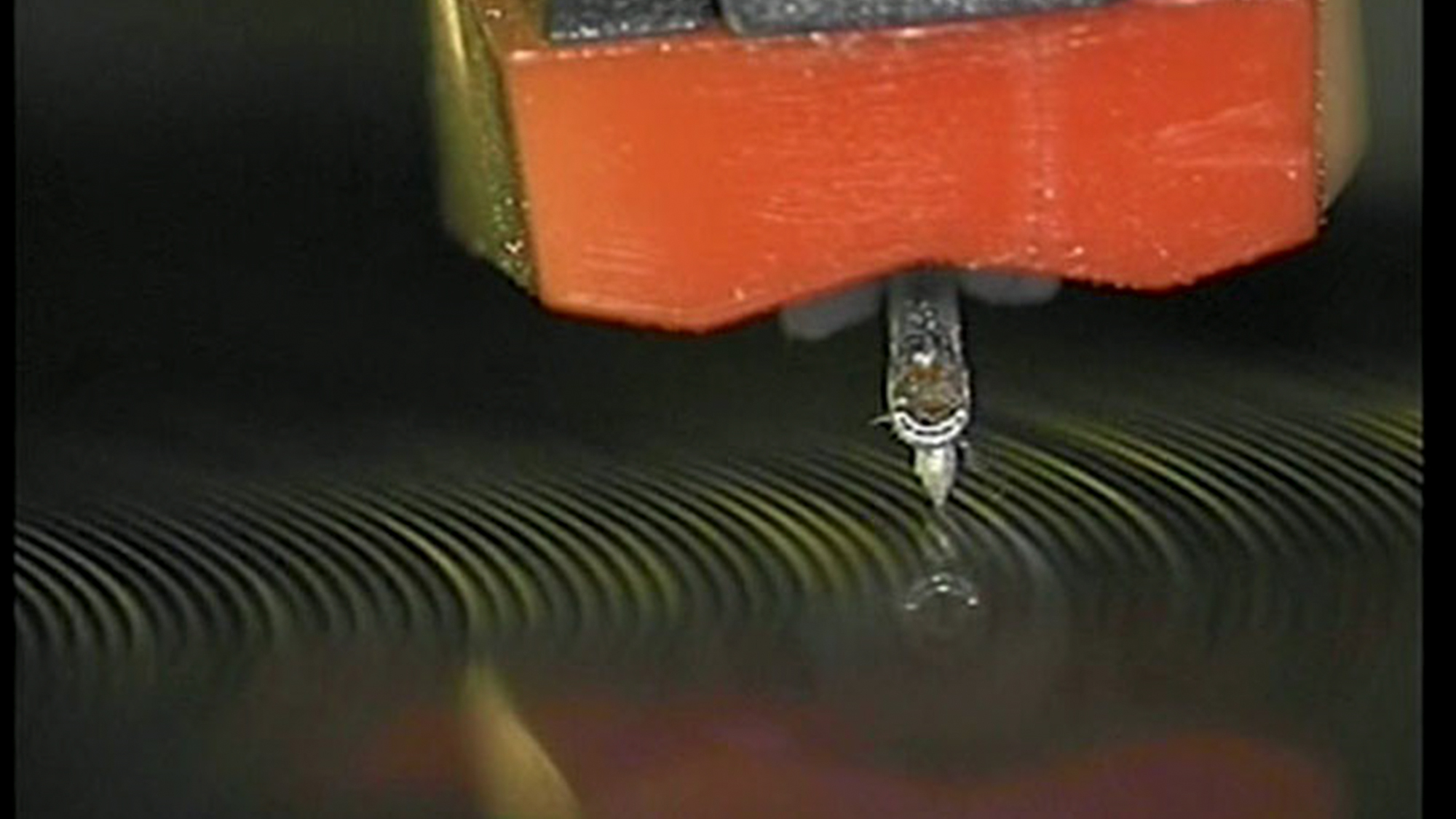
Bouquet film / video 11
Portraits of composers, portraits of music (Joan Logue and Robert Ashley)
La Centrale, Wednesday, November 12 to Sunday, November 16, 2025
For three months, a program of films and videos offers a journey through half a century of moving images, exploring some of the possible articulations between sound, music and image. Through a series of thematic "bouquets" or ones centered on a particular filmmaker or video artist, the program presents the work of emblematic or little-known artists, video art pioneers or film thurifers.
In a dialogue between projected works (room 1) and works on cathode-ray monitors (room 2), between formal, ethnographic and political approaches to sound, the program highlights the uses and practices of the musician's portrait, performance and soundscapes.
Each week, the films and videos disseminate discreet touches, apparitions and motifs, connections between bouquets and nods to the Biennial program: Paganini, a Sony Walkman, Jean-Luc Godard revisited by John Zorn, salt deserts, the Bachmann / Ceresole couple, brass bands and more.
A proposal by Maxime Guitton.
Hall 1
Joan Logue, 30 Second Spots: New York
1981-82, 14'45'', video, color, sound
Collection du Fonds d'art contemporain de la Ville de Genève (FMAC)
The desire to give greater visibility to her fellow artists and neighbors prompted Joan Logue in 1979 to begin a series of video portraits entitled 30 Second Spots, financed by the National Endowment for the Arts and co-produced by The Kitchen. In it, she hijacks the television format of commercials, devoting one or more episodes to each artist (29 in all for the New York series).
With John Cage (composer), Meredith Monk (composer), Arnie Zane & Bill T. Jones (dancers), Maryanne Amacher (composer), Robert Ashley (composer and author), Charlemagne Palestine (composer), Simone Forti (choreographer), Carles Santos (composer), Spalding Gray (author and performer), Richard Teitelbaum (composer), Steve Reich (composer), George Lewis (composer), Tony Ramos (performer), David Behrman (composer), Charlemagne Palestine (performer), Douglas Ewart (composer), Max Neuhaus (composer), Joan Jonas #1 (performer), Joan Jonas #2 (performer), Steve Reich #1 (composer), Steve Reich #2 (composer), Liz Phillips (composer, sound artist), Philip Glass (composer) and Michael Nyman (composer).
Joan Logue, 30 Second Spots: Paris
1983, 12'21'', video, color, sound
Collection du Fonds d'art contemporain de la Ville de Genève (FMAC)
Joan Logue focuses on artists, writers and musicians working in Paris. Using elegant special effects and close-ups, she captures her subjects in moments of intimacy and contemplation, in a very condensed time (19 episodes).
With Pierre Boulez (composer), David Hockney (painter), Philippe Sollers (writer), Maurice Roche (poet and writer), Orlan (performance artist), Andreas Senser (painter), Jean-Claude Eloy (composer), Dominique Desanti (writer), Robert Doisneau (photographer), Philippe Sollers (writer), Takis (painter), Valère Novarina (writer), Jochen Gerz (performance artist), Jean-Toussaint Desanti (writer), Julia Kristeva (writer) and her son David, Tod Machover (composer), Jacques Monory (painter), Ushio Amagatsu (performance artist) and Stewart Sherman (performance artist).
Joan Logue
Born in 1942 (USA)
Based in New York City
Joan Logue is a pioneer of video portraiture, which she began in 1971, first filming strangers and neighbors, then capturing major figures in art and culture - Judy Chicago, Ellsworth Kelly, Vija Celmins, Michael Heizer, Diamanda Galás and many others. Her videos, which vary in length, explore presence, intimacy, silence and temporality, renewing the genre of traditional portraiture. Joan Logue also works on thematic projects such as Artists' Diaries, combining interviews and studio footage, or Civil Rights Pioneers (1989-2009), which brings together Rosa Parks, Cesar Chavez and Barack Obama.
Room 2
Robert Ashley, MUSIC WITH ROOTS IN THE AETHER
Video Portraits of Composers and their Music
1976, 7x120', video, color, sound
MUSIC WITH ROOTS IN THE AETHER: Programs 1 & 2 (David Behrman, Philip Glass)
1. Landscape with David Behrman (57'40''). The Music Of David Behrman: Music With Melody-Driven Electronics (57'40'')
2. Landscape with Philip Glass: The Fourth Grade Class, P.S. 41, New York City (57'40''). The Music Of Philip Glass: Music in 12 Parts, Part 2 & Einstein on the Beach (50'57'')
MUSIC WITH ROOTS IN THE AETHER: Programs 3, 4 & 5 (Alvin Lucier, Gordon Mumma, Pauline Oliveros)
3. Landscape with Alvin Lucier (57'40'') : ...Including The Performance Of Outlines Of Persons And Things (1975). The Music Of Alvin Lucier: Bird And Person Dyning (1975) & Music For Solo Performer (1965) (57'40'')
4. Landscape with Gordon Mumma (57'40''). The Music of Gordon Mumma: Some Voltage Drop (1974): Simulcast, Schoolwork & Telepos/Foxbat (57'40'')
5. Landscape with Pauline Oliveros (57'40''): Including Unnatural Acts Between Consenting Adults, a collaboration with Carol Vincius. Landscape with Pauline Oliveros (continued). The Music Of Pauline Oliveros: Rose Mountain Slow Runner (57'40'')
MUSIC WITH ROOTS IN THE AETHER. Programs 6 & 7 (Robert Ashley, Terry Riley)
6. Landscape with Terry Riley (57'40''). The Music of Terry Riley: Shri Camel: Morning Corona (46'03'')
7. Landscape with Robert Ashley (57'40''): What She Thinks (It's History). The Music of Robert Ashley: Title Withdrawn (45'00'')
MUSIC WITH ROOTS IN THE AETHER (1976) is a series of seven television portraits imagined and directed by Robert Ashley, devoted to some of the most important figures in post-war American experimental music. Each episode consists of a long interview filmed by Ashley in a minimalist style - fixed shots, no classical editing - followed by musical performances filmed in an equally contemplative manner. The composers featured are David Behrman, Philip Glass, Alvin Lucier, Gordon Mumma, Pauline Oliveros, Terry Riley and Robert Ashley himself. With a total running time of almost 14 hours, this audiovisual work offers an intimate, non-spectacular approach to musical creation, giving the artists the chance to talk about their ideas, their creative processes and their relationship with sound. A veritable living archive, MUSIC WITH ROOTS IN THE AETHER captures the spirit of a generation of musicians who have redefined the boundaries between music, technology and performance.
Translation of program notes by Robert Ashley :
MUSIC WITH ROOTS IN THE AETHER
Video portraits of composers and their music
Produced and directed by Robert Ashley
Philip Makanna, director of photography; Maggi Payne, sound recordist; Jerry Pearsall, video cameraman; William Farley, conceptual consultant; Pat Kelly, camera assistant. Additional sound recording: Peg Ahrens, David Behrman, Peter Gordon and Marc Grafe.
MUSIC WITH ROOTS IN THE AETHER is a musical theater work in color video. It's the final version of an idea I've been thinking about and working on for several years: to make a large collaborative work with other composers whose music I love. Initially, I had hoped that this might take the form of a live performance, in a very different form, but this proved too impractical to contemplate for long. Of the possible choices, video is by far the best medium for many reasons.
The collaborative aspect of MUSIC WITH ROOTS IN THE AETHER lies in the theatricality of the interviews, mainly at least! I am indebted to all the composers involved for their generosity in allowing me to represent them in this way.
The work also reveals itself to be a vast documentation of an important style that emerged in American concert music around 1960. These composers of the "post-serial" / "post-Cage" movement all gained international renown for the originality of their work and for their contributions to this field of musical composition.
The style of the video presentation comes from the need I felt to find a new way of showing music being played. I've always been opposed to the sense that television camera editing - derived from the most banal and poorest considerations of cinema - gives to music. (Cinema is edited, above all, because it has to be. Cameras can only run for a few minutes at a time. Anyone who has ever tried to film music has had to deal with this problem. Then the habit moved to television). The idea behind the visual style of MUSIC WITH ROOTS IN THE AETHER is simple: observe the performers' action as closely as possible and don't "cut" the visual material - that is, don't editorialize on musical time by arbitrary substitutions of space and time.
The visual style of showing music in the making became the "theater" (stage) of the interviews, and the composer portraits were designed to unfold in this style.
I'm also indebted to the artists who helped bring this music/video style to life during the recording process. In particular, I think Philip Makanna's framing ideas and Maggi Payne's sound recording mobilize a form of concentrated attention that is very new to "visual" media, and more akin to music than film or television.
- Robert Ashley
Robert Ashley
(1930-2014)
Resided in New York City
A central figure in the New York musical avant-garde, Robert Ashley is best known for his "television operas", such as Perfect Lives (1983), which combine spoken voice, electronics and poetic narration. Co-founder of the Sonic Arts Union with Alvin Lucier, David Behrman and Gordon Mumma, Ashley was an early explorer of the potential of technology and synthesizers in composition. His work, marked by the singular use of voice, the rhythm of language and social critique, has had a profound influence on contemporary music and multimedia performance.






